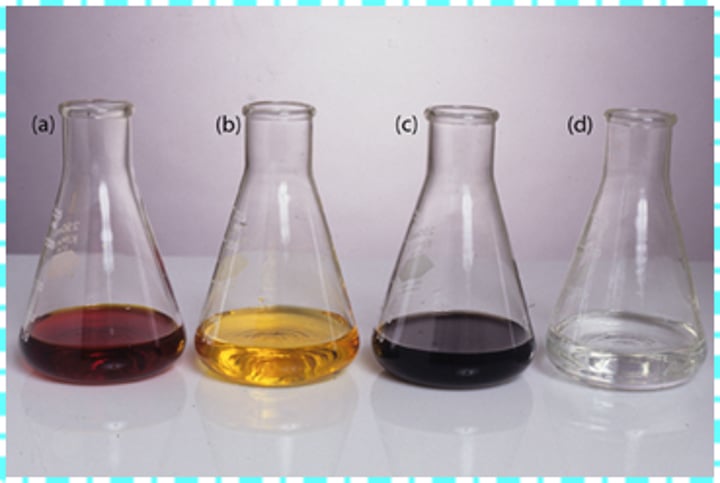15.1/ ES 5- Sodium thiosulphate titrations
1/15
There's no tags or description
Looks like no tags are added yet.
Name | Mastery | Learn | Test | Matching | Spaced |
|---|
No study sessions yet.
16 Terms
What can sodium thiosulphate titrations be used for?
Finding the concentration of an oxidising agent, the more concentrated the oxidising agent is the more ions will be oxidised by a certain volume of it
Specifically can be used to determining the concentration of sodium chlorate (I) in bleach
What compounds can be titrated with sodium thiosulphate?
Can be done with any oxidising agent, the procedure is the same and so are the calculations
What sort of reaction are sodium thiosulphate reactions?
Redox titration not an acid-base reaction/ titrations
Gives the three equations for the three reactions that occur in these experiments when bleach is used, explain each one
Step 1: Chlorine reacts with sodium hydroxide to make sodium chlorate(I)-NaClO (NaOCl is bleach)
2 NaOH +Cl2 --> NaCl + NaOCl + H2O
Step 2: Chlorate and iodide ions react to form iodine and forms a brown solution (Iodine)- redox reaction
ClO- + 2I- + 2H+ --> I2 + Cl- +H2O (Iodine is brown)
Step 3: Iodine produced is titrated with sodium thiosulphate and the iodine molecules reacts with the thiosulphate ions and form a clear solution
2S2O32- + I2 --> 2I- + S4O62-
What is used as an indicator, explain why?
Starch- Endpoint clearly seen when starch solution is added- end point when final trace of black/blue colour is no longer visible this is when all of the iodine has reacted. It is easier to see blue-black to colourless than yellow to colourless (reduces human error)
Describe the 4 colour changes that occur in this experiment
a) Iodine is brown
b) It goes colourless as it reacts (it will therefore get paler as it goes to colourless) and becomes a yellow solution/ straw coloured
c) When straw coloured add starch which gives a very dark blue-black colour with iodine.
d) Titrate until colourless

What are the four steps needed to calculate the number of molecules in the undiluted bleach sample from a sodium thiosulphate titration?
Step 1: Number of moles of iodine
Step 2: Number of moles of chlorate ions
Step 3: Concentration of the diluted bleach
Step 4: Concentration of the undiluted bleach
What is the use of being able to calculate the concentration of chlorate ions?
Can compare with other bleaches- calculate how cost-effective they are
What are the two main equations for this experiment?
ClO- + 2I- + 2H+ I2 + Cl- +H2O
(this happens in the conical flask that you titrate into)
2S2O32- + I2 2I- + S4O62-
(this is the titration step)
How would you calculate the number of moles of iodine (Step 1)
The titration step allows you to work out how many moles of iodine (I2) have reacted with the sodium thiosulfate
2S2O32- + I2 2I- + S4O62-
You can use the equation n = c x V as you would in your standard titration to find the number of moles of sodium thiosulfate that reacted
You can then use the ratio from the equation above to find the number of moles of I2
The ratio of iodine molecules to thiosulphate ions is 1:2 so divide the number of thiosulphate ions that reacted by two to find the number of iodine molecules that reacted
How would you calculate the number of moles of chlorate ions (Step 2)?
Once you know how much iodine was produced by the sodium chlorate (I), you can then calculate how much sodium chlorate (I) there was in the original bleach using the equation below
ClO- + 2I- + 2H+ I2 + Cl- +H2O
You know the number of moles of I2 therefore, from the equation above, you can use the ratio to find the number of moles of sodium chlorate (I)
The ratio of iodine molecules (from last calculate): chlorate ions is 1:1
How would you calculate the concentration of the dilute bleach (Step 3)?
Use the number of moles from the previous calculation and c = n/v to calculate the concentration of the chlorate ions and so the bleach
How would you calculate the concentration of undiluted bleach (Step 4)?
If you have made up a solution of diluted bleach from a stronger solution then you need to work out the dilution factor
Dilution factor = Total volume of diluted bleach made/ volume of undiluted bleach used
Multiply the concentration calculated for the diluted bleach by the dilution factor to calculate the concentration of the undiluted bleach
What is the equation for the dilution factor?
Dilution factor = Total volume of diluted bleach made/ volume of undiluted bleach used
Name and explain 6 factors that may make the titration inaccurate
1. Using contaminated apparatus- make sure burette is clean- rinse it with sodium thiosulphate before starting, any traces of water will dilute the solution
2. Read the burette correctly (bottom of meniscus, eyes level with the liquid)
3. Reduce the effect of anomalies- do one trail, then repeat until you have at least 2/3 concordant results within 0.1cm3 of each other then take a mean average of these results, do not include the trail or the anomalies in the mean average
4. Remember to wash the flash between repeat experiments or use a new, clean one
5. If you use starch solution too soon during the titration the iodine will "stick" to the starch and won't react as expected with the thiosulphate making the result unreliable, only add the starch when the solution is pale yellow
6. Some oxidising agents react very slowly with oxygen in the air so they should be make up freshly as soon as possible
Which equation should be used to calculate the original concentration without the dilution factor?
c1 x v1 = c2 x v2